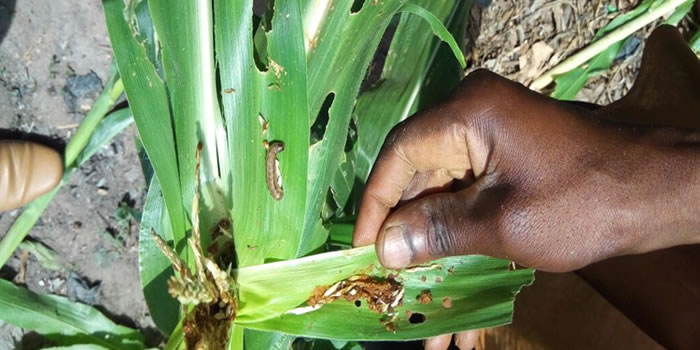Adverts
AGRICULTURE
Fall armyworms invade communities in Atwima Kwanwoma District
Farming folks in Nweneso II and Daako communities in the Atwima Kwanwoma District are calling for urgent action to halt the spread of a pest that is destroying maize crops and feared spreading rapidly across the district.

Date Created : 7/14/2020 1:48:13 AM : Story Author : Ghanadistricts.com
Their livelihoods, they say are at risk as the non- native insects threaten other cash crops such as Cocoa in the district. This unfortunate development poses a major threat to food security and in the district.
An engagement with the officer in charge of Agriculture in the district recognized the difficulty in controlling the invasive species which is spreading quickly in tropical zones.
The “Fall Armyworm”, so-called because it eats its way through most of the vegetation in its way as it marches through crops. Further questioning revealed that the Fall Armyworm is a native to North and South America and was identified for the first time in Africa last year.
According to Experts, the invasive species is actually not a worm but a hungry Caterpillar that eats up crops before it grows into a butterfly. They lay their eggs on seedlings and leaves of plants and alarmingly, within 5 to 10 days they are hatched and launch a massive onslaught on food crops including maize and cowpea.
Available data emanating from the Agriculture Ministry reveals that some 4,500 hectares of Farmlands were destroyed by the Fall Armyworm infestation in Ghana last year. It is also recorded that since March this year, the invasive species have destroyed more than 1,370 hectares of maize, cowpea and cocoa farms with the regions- Brong Ahafo, Ashanti and Western being the most affected areas.
What Experts say is strange and dangerous about the Falling Armyworm infestation is its modus operandi as the Caterpillars feed and damage the leaves and inside whorls of young maize plants resulting in small shot holes or large ragged and elongated holes on the plant.
Indeed, the Caterpillars tend to enter through the side of the ear and feed on developing kernels in contrast to the traditional stem borer caterpillars that normally enter the ear from the top or the bottom. The infestation then causes stunting and destruction of developing tassel and kernels, thereby reducing grain quality and yield.
Obviously, the Fall Armyworms are migratory and that, there is a need for cross border collaborative efforts of Governments of Ghana and her neighboring countries to develop the most effective and pragmatic strategies to tackle them.
For now, the poor peasant Farmer at the local level is helpless and most vulnerable to control the onslaught of the deadly infestation on their crops, which potentially threatens their livelihoods. The infestation is widespread and massive that even if one Farmer should spray his/her farm, the disease will still spread to other farms. Certainly, one individual Farmer cannot control it and so a national mass spraying exercise is urgently advocated amidst an extensive sensitization educational programme.
Meanwhile, it is most refreshing and assuring to hear the sector’s Minister, Dr. Akoto Osei outlining some policy interventions to permanently deal with the situation, we, however, dare to suggest that the phenomenon be treated as a national security issue as Ghana risk her quest to making the country more food secure under the policy initiative “Planting for Food and Jobs”


 facebook
facebook twitter
twitter Youtube
Youtube TOLL FREE 0800 430 430
TOLL FREE 0800 430 430 +233 593 831 280
+233 593 831 280 GPS: GE-231-4383
GPS: GE-231-4383 info@ghanadistricts.com
info@ghanadistricts.com Box GP1044, Accra, Ghana
Box GP1044, Accra, Ghana